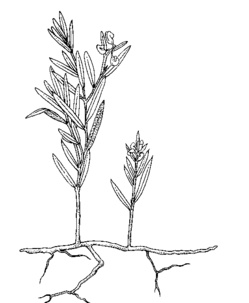Grevillea obtusiflora R.Br. APNI* 
Description: Spreading shrub, usually 0.2–2 m high, sometimes root-suckering.
Leaves narrow-elliptic to linear-revolute, 1.5–6 cm long, 2–9.5 mm wide, margins entire, recurved to revolute, lower surface loosely villous or subsericeous.
Inflorescences often decurved, 0–3-branched, 2–18-flowered. Perianth reddish, often with green or yellow towards base, pubescent outside, bearded usually above the middle inside. Gynoecium 14–26 mm long; ovary densely hairy and ± sessile; style reddish, subvillous.
Follicle usually hairy, without dark stripes or blotches.
Flowering: Flowers spring and summer.
Distribution and occurrence: Grows in sandy loam soils in open low scrub beneath dry sclerophyll forest in the Kandos area.
NSW subdivisions: CT
Threatened species: NSW BCA: Endangered; Commonwealth EPBC: Endangered
Text by R. O. Makinson
Taxon concept:
| | Key to the subspecies | |
| 1 | Leaves 1.5–5 mm wide, narrow-elliptic to narrow-obovate, margins usually shortly recurved to revolute leaving most of the lower surface exposed; lower surface of leaf densely subsericeous (surface of leaf not visible between hairs); branchlets not usually secund; perianth 2.5–3 mm across; gynoecium mostly 20–23 mm long; rhizomatous low shrub 0.2–0.3 m high, sterile | subsp. obtusiflora |
| Leaves 1–1.2 mm wide, sublinear to narrow-elliptic, margins strongly revolute, completely enclosing the lower surface of the leaf; lower surface of leaf, when visible, with an open appressed indumentum (leaf surface clearly visible between hairs if viewed with a hand lens); branchlets usually strongly secund;perianth sometimes entirely cream; gynoecium usually 15–19 mm long; rhizomatous shrub 0.3–0.7 m high,rarely to 2 m high, fertile | subsp. fecunda |
APNI* Provides a link to the Australian Plant Name Index (hosted by the Australian National Botanic Gardens) for comprehensive bibliographic data
***The AVH map option provides a detailed interactive Australia wide distribution map drawn from collections held by all major Australian herbaria participating in the Australian Virtual Herbarium project.
|


